Why Is Food Safety Important In Healthcare? Healthcare Leaders Guide
Learn challenges healthcare foodservice teams face today and key food safety practices to protect vulnerable patients. Get a free healthcare leader...
Cross contact contamination is when parts of a food allergen come directly or indirectly in contact with an allergen-free food.
As a food business owner or a food safety manager, it is part of your responsibility to ensure that every customer you receive in your facility is aware of the potential allergen content in your foods. Similarly, it is the responsibility of the owner to train the team on how to minimize the occurrence of cross-contact.
Cross-contact refers to the transfer of an allergen protein from an allergenic food to a non-allergenic one. The dangers of allowing cross-contact to occur are very significant.
The negative effects of consuming allergenic foods may sometimes become life-threatening and can lead to serious consequences for your food business. A simple peanut allergy can cause an anaphylactic reaction that can lead to death when not addressed immediately.
Food allergens only require a very small amount to trigger an allergenic effect on allergen-sensitive people. Cross-contact can occur at any point in the food supply chain. With this information at hand, the significance of proper handling to prevent cross-contact makes the operation a matter of life or death.
Contrary to other types of food contamination, such as biological hazards, allergens are not guaranteed to be removed by cooking. Cross-contact with allergens will only take very small morsels of food to trigger a reaction. In the US, 8 major food allergens are recognized by the FDA:
Key takeaways
Cross-contact generally only refers to the transfer of food allergens, whereas cross-contamination includes biological, chemical, and physical hazards. If you have ever heard of the term cross-contamination, you might be asking yourself: are cross-contact and cross-contamination the same? Do not be confused as cross-contact is a concern quite specific for food allergens.
Additionally, the effects of the two terms are different. While cross-contact causes allergic reactions, cross-contamination can lead to a foodborne illness or food poisoning. Most agents of cross-contamination, especially biological and physical hazards, can be removed through cooking or manual operations, respectively. In terms of cross-contact, once an allergen source comes in contact with the food, then it is already considered unfit for potentially allergic customers.

As mentioned, cross contact can happen at any point in the food supply chain. Cross contact is a huge concern for any food establishment and any food handler must be properly oriented on how to avoid it from occurring. The first step to doing this is to learn the pathways at which cross contact can occur. Without proper segregation, handling, and food storage process, cross contact can easily occur.
Generally, cross-contact can occur in two ways:
Direct cross contact. This type of cross contact refers to the direct application of an allergenic food to an allergy-safe food source. This may occur accidentally or unintentionally through food-to-food contact.
Indirect cross contact. Using the same utensils and food equipment to process allergenic and non-allergenic foods is considered an indirect cross contact. When you use the same knife to cut cheese and cooked meat, the resulting dish is considered contaminated with the allergen.
Remember that removing the allergen from the contaminated food does not guarantee that no food allergen remains on the meal. This applies to both direct and indirect cross contact. If you accidentally put shrimp on a dish, manually removing them does not guarantee that the food dishes will not cause any effects on the consumers.
Similarly, simply wiping off utensils without washing and sanitizing them in between uses can still potentially cause allergenic reactions. Make sure that your team has a proper system for avoiding the occurrence of cross-contact.

Cross contact occurs when food handlers disregard cleaning of food contact surfaces and utensils in between use. Because food allergens can be transmitted through very small particles, the risk of cross-contact must be managed as much as possible. Offering allergenic foods as part of your menu requires an adjacent strong food safety management system (FSMS) for customers with special diets and health issues.
As part of every team's FSMS, food handlers must be able to recognize cross-contact to avoid them from occurring. Here are 4 very common examples of cross contact throughout the supply chain:
In this section, we discuss some of the most common occurrences of cross-contact:
This occurrence would be fatal for people with celiac disease. Another example would be during refrigerated storage. Cross contact can occur when allergenic foods are stored in the same compartment or refrigerator without even putting them in air-tight, separate storage containers.

Cross-contact can occur in many different ways. It can be direct contact with an allergenic food or indirect contact through an uncleaned utensil. Regardless of how it happens, your business is at risk once a food safety complaint regarding this matter occurs. For food businesses that serve foods with allergens or prepare non-allergenic foods together with those that have allergens, you must always be prepared with a food allergy warning.
Mainly, cross contact increases the risk of food safety hazards as well as negative economic impact. Customers who unknowingly consume foods contaminated through cross contact can be put in a life-threatening situation from the adverse reactions of their body to the allergen. Your food business is then liable to address this concern by contacting the local health department as well as applying first aid to the customer.
Additionally, after such an incident occurs, your food business and brand name can be subject to negative publicity. This effect can significantly lower your profits as you lose customer confidence. Your team may also face sanctions such as a mandatory inspection, fines, or worse, criminal charges.
Here are some of the most effective ways to avoid cross-contact:
Avoiding cross contact is not an impossible task. There are many precautions that can become vital parts of your food safety management system. In trying to avoid cross contact, knowledge and adequate preparation are key to achieving food safety assurance.
Clean utensils, cutting boards, and cooking pans with soap and water both before and after use would prevent cross-contact when preparing an allergen-free meal. Designate separate utensils and dishes for allergy-safe foods, and consider using different colors for these kitchen tools. If preparing multiple dishes, cook allergy-safe foods first.
When food handlers are well-oriented with what is cross-contacted in food, their risks, and their sources, your team becomes more efficient in handling foods — especially if they fall in the allergen category.
At FoodDocs, we offer a digital Food Safety Management System that can help you ensure that all tasks to avoid cross-contact and other operations are always done efficiently.

With the help of AI, you can create your digital FSMS in just an average of 15 minutes! All you need to do is answer a few basic questions about your operations. After this step, our machine learning program cross-references your tasks with other similar operations and creates a digital FSMS built specifically for your food safety tasks.

Specifically, when you sign up for our digital FSMS product, you will get the following:
At FoodDocs, we aim to make every food that will come out from your food business safe. Additionally, our team envisions a food industry where food safety compliance is not a repetitive task and is seen as a burden by some. Our system was built to make food safety compliance an easy and enjoyable task. With our digital FSMS, you can save at least 20% of your time from supervising your team and help you focus on other aspects of your food business.
With the fast-paced changes in the food industry and stricter food safety regulations, what your business needs are an efficient and continuously improving smart system. If you want to check if our digital FSMS is the perfect fit for your needs, try our free, 14-day trial to check our system features. Join our list of more than 15,000 customers who are enjoying food safety compliance without digital FSMS.
Learn challenges healthcare foodservice teams face today and key food safety practices to protect vulnerable patients. Get a free healthcare leader...
Learn what Standard Operating Procedures (SOPs) are and how to write effective SOPs that ensure consistency, efficiency, and safety in your...
Boost your retail food safety with essential practices and digital tools to protect customers and your brand. Plus a free Retail Food Safety Leader...